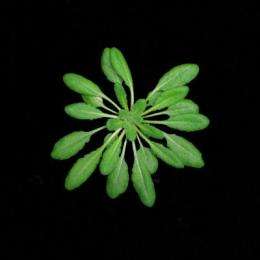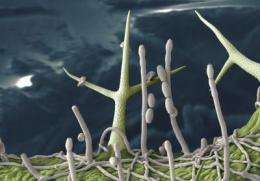The dilemma of plants fighting infections

Individuals of one and the same plant species often differ greatly in their ability to resist pathogens: While one rose succumbs to bacterial infection, its neighbour blissfully thrives. Scientists from the Max Planck Institute of Developmental Biology in Germany have tracked down an explanation for this common phenomenon. Their conclusion: disease resistance can incur high costs.
Especially resistant plants of mouse ear cress (Arabidopsis thaliana) produce fewer and smaller leaves, and have a competitive disadvantage in the absence of enemies. Whether it is better to invest in disease resistance or biomass is thus very much dependent on the unpredictable circumstances a plant may find itself in. Therefore both large, but vulnerable plants co-exist in nature with small, but well-protected ones (Nature, June 3rd 2010).
In the course of evolution, plants have invented many ways to defend themselves against enemies. Some produce smelly or bad-tasting ingredients, others develop thorns or have a particular effective immune response to viruses and bacteria. If selection pressure is sufficiently high, one would thus expect only those individuals to survive that are best protected. Pathogens, in turn, should have a difficult time. Everybody knows that this is not the case. Indeed, plants vary tremendously in their ability to defend themselves, and this is true not only for different species, but also for members of the same species.

The group of Detlef Weigel at the Max Planck Institute for Developmental Biology has now tracked down a variant of the ACD6 gene, which functions as a universal weapon in the fight against predators. With it, the plants both produce much more of a chemical that is directly toxic to microbes and more signalling molecules important in immunity. These enable mouse ear cress plants to combat a wide range of enemies, from bacteria and fungi to insects such as aphids. However, not all varieties have this variant. While it occurs throughout the area where mouse ear cress grows, from North Africa to Scandinavia, and from Central Asia to Western Europe, at any given place it is found in only about 20 percent of individuals. This already suggests that this variant might also confer some disadvantages.
"We could show that this gene makes plants resistant against pathogens, but at the same time it slows down the production of leaves and limits the size of leaves, so that these plants are always smaller than those that do not have this variant," said Detlef Weigel. "But as soon as they are being attacked, the plants with the special ACD6 variant have a leg up compared to plants with the standard version. On the down side, at places or in years where there are few enemies, they are penalized and lose out compared to the larger fellow plants." Smaller size eventually leads to reduced number of seeds and hence to fewer progeny. The conclusion of Weigel: "Just as in human society, there is no free lunch in nature."
More information: M. Todesco, et al., Natural allelic variation underlying a major fitness tradeoff in Arabidopsis thaliana. Nature, June 3rd 2010
Provided by Max-Planck-Gesellschaft


















